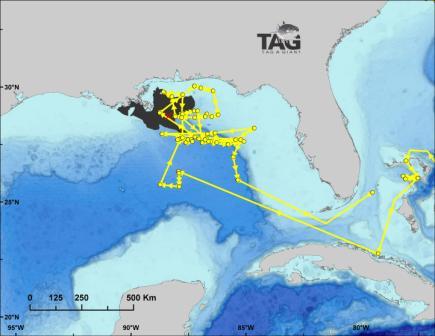Worth a Thousand Words
Bluefin tuna is an exceptionally valuable fish and its catch it tightly controlled. Unfortunately, this species sometimes ends up in the nets as bycatch of yellowfin tuna or marlin fishing. Changes in gear and fishing techniques are capable of reducing the bluefin bycatch only to a certain extent. An additional method to use to avoid unintentional catch of bluefin is to avoid places where this species is found at times when it is present there. For this to be effective, it is important to know both the spatial and temporal patterns of bluefin tuna migration and spawning.
In Comparative Influence of Ocean Conditions on Yellowfin and Atlantic Bluefin Tuna Catch from Longlines in the Gulf of Mexico, authors Steven L. H. Teo and Barbara A. Block tagged bluefin tuna with radiotrasnmitters and followed their movements inside the Gulf of Mexico over a period of five years. They combined the data with the information from observations and catches from previous several years and made maps comparing bluefin and yellowfin geographical distributions at different times of year and in responses to various environmental influences.
Importantly, according to their data, bluefin tuna spawns in the Gulf of Mexico during April and May, just off the coast of Louisiana.
Their article was published in PLoS ONE last week, on May 28th 2010. During the process of submission, peer-review and preparation of the article for publication, the Gulf of Mexico experienced the disastrous Deepwater Horizon oil spill, starting on April 20th. This catastrophic event suddenly made this article much more timely than originally intended. While this image did not make it into the article itself, the authors have provided it as a part of their press package – one of their maps – of bluefin migrations and spawning – overlaid with the location, shape and size of the oil spill as of last week. Yes, the fish were in the area, trying to reproduce, just as the spill happened. The overlap is eery:
Caption: The track (yellow line) and daily positions (dots) of a giant bluefin tuna electronically tagged off Canada on October 25, 2008 – which spent the period from March 23-May 24, 2009 in the Gulf of Mexico. The track is overlaid on the area of the Deepwater Horizon oil spill as of May 24, 2010 (black). Peak spawning of bluefin tuna occurs in this area during April and May. Image courtesy of Tag-A-Giant Foundation and Stanford University.
This picture is worth a billion words….
From the Abstract of the article:
Directed fishing effort for Atlantic bluefin tuna in the Gulf of Mexico (GOM), their primary spawning grounds in the western Atlantic, has been prohibited since the 1980s due to a precipitous decline of the spawning stock biomass. However, pelagic longlines targeted at other species, primarily yellowfin tuna and swordfish, continue to catch Atlantic bluefin tuna in the GOM as bycatch. Spatial and temporal management measures minimizing bluefin tuna bycatch in the GOM will likely become important in rebuilding the western Atlantic bluefin stock. In order to help inform management policy and understand the relative distribution of target and bycatch species in the GOM, we compared the spatiotemporal variability and environmental influences on the catch per unit effort (CPUE) of yellowfin (target) and bluefin tuna (bycatch). Catch and effort data from pelagic longline fisheries observers (1993–2005) and scientific tagging cruises (1998–2002) were coupled with environmental and biological data. Negative binomial models were used to fit the data for both species and Akaike’s Information Criterion (corrected for small sample size) was used to determine the best model. Our results indicate that bluefin CPUE had higher spatiotemporal variability as compared to yellowfin CPUE. Bluefin CPUE increased substantially during the breeding months (March-June) and peaked in April and May, while yellowfin CPUE remained relatively high throughout the year. In addition, bluefin CPUE was significantly higher in areas with negative sea surface height anomalies and cooler sea surface temperatures, which are characteristic of mesoscale cyclonic eddies. In contrast, yellowfin CPUE was less sensitive to environmental variability. These differences in seasonal variability and sensitivity to environmental influences suggest that bluefin tuna bycatch in the GOM can be reduced substantially by managing the spatial and temporal distribution of the pelagic longline effort without substantially impacting yellowfin tuna catches.

